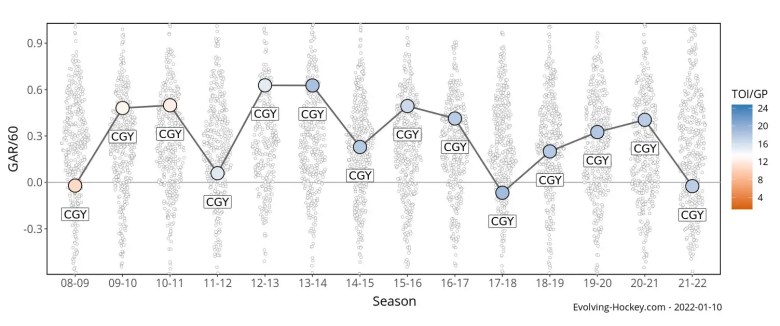Since being drafted in 2007, Mikael Backlund has played 777 NHL games, each and every one with the Calgary Flames. In that time he has established himself as a key part of the team on the ice and as a leader in the room.
This season, the Flames are having one of their most successful season since he cracked the NHL roster full time in 2010. Despite this, Backlund has struggled individually, leading to concerns that age has begun to catch up to the 32-year-old.
Backlund has generally been reliable as a shutdown player at even strength and on the penalty kill, while still mustering 40–50 points a season for the team. But now, his offense seems to have slowed down. With just 11 points in 33 games so far this season, he is on pace for only 27 points over the full 82 games.
This begs the question, is it the end of the Mikael Backlund golden age? Has the inevitable age related decline begun, or is Backlund likely to bounce back and return to pace as he has in the past?
Backlund’s career goals above replacement
Looking at his rate of goals above replacement (GAR) from Evolving-Hockey, it looks like his season has been fairly catastrophic after years of gradual, age-defying improvement between 2018–19 and 2020–21.

Using a more process-based and less results-based metric, expected GAR (xGAR), the story is somewhat different, and a little more promising. Although the days of his peak have also long passed in terms of xGAR, his recent performance has been pretty steady, and is actually net positive.

Both stats show a decline from higher peaks in his younger days, and while GAR showed an improvement followed by a stark decline, xGAR shows his on-ice performance has been much the same as the previous three seasons, and even shows a little improvement.
Reasons for optimism
In reality, Backlund’s fundamentals are still sound—his on-ice production just isn’t there. What we’re seeing this season is a lack of finishing hampering the on-ice results for both himself and his linemates.
Matchsticks and Gasoline pointed out recently that Backlund typically heats up later in the season, so maybe his dip in xGAR from last season can be attributed to his characteristic slow start rather than age related decline. Still, his pace of 0.34 points per game is alarmingly low over two months of hockey already in the rearview mirror.
Beyond his own pattern of starting slowly and them ramping up down the stretch, its also worth mentioning that his on-ice shooting percentage, that is the shooting percentage of the team as a whole while he’s on the ice, is just 4.4% at even strength and 5.5% in all situations.
Both are incredibly low values that are likely to rebound. In particular, the on-ice shooting percentage should turn around when players like Blake Coleman start converting on their chances.
If that rebound comes it should put him back on track to finish the season with similar numbers as his usual. But individually, at 32, a rebound in Backlund’s shooting percentage may be less likely.
Often, the offensive touch is the first skill a player loses with age. Whether or not Backlund can pull off the same quality of late season charge at 32 is a difficult question to answer.
The realities of age
Never known for his goal scoring, Backlund’s finishing touch does seem to already be suffering with age. Looking at how many expected goals Backlund converts to goals, there has been a steady decline in efficiency over the last several years.

This diminishing ability to convert on chances will make it more difficult for Backlund to attain the point totals he has in the past. Already, its effects can be found in his goal scoring numbers.
| Season | GP | G/GP | A/GP |
|---|---|---|---|
| 2018–19 | 77 | 0.3 | 0.3 |
| 2019–20 | 70 | 0.2 | 0.4 |
| 2020–21 | 54 | 0.2 | 0.4 |
| 2021–22 | 31 | 0.1 | 0.2 |
So, even if he does have a late season charge, it’s not likely to be as high as it has been in the past.
While this does most likely signal the start of Backlund’s decline, it doesn’t mean he will become an ineffective player by any means. As shown by his xGAR, he has remained near or above replacement level despite declining offensive output.
This can likely be attributed to his solid defensive play throughout his career. By remaining a useful defensive player, Backlund has the opportunity to age more gracefully than most.
Father Time catches everyone
Backlund is a good player and still an important part of the Flames. This isn’t supposed to be an indictment of his play, but an acknowledgement of where he’s at in his career.
The stats show that he remains about as effective overall as he has been in the past, but with less offensive punch. The Flames need to understand that with each passing season, the likelihood he rediscovers that touch becomes smaller.
Hopefully he finds another gear like he has in the past, but the Flames would be smart not to bet on it. At the end of the day, for a team lacking scoring, Backlund’s inevitable decline must be factored in when planning future roster moves.

You must be logged in to post a comment.